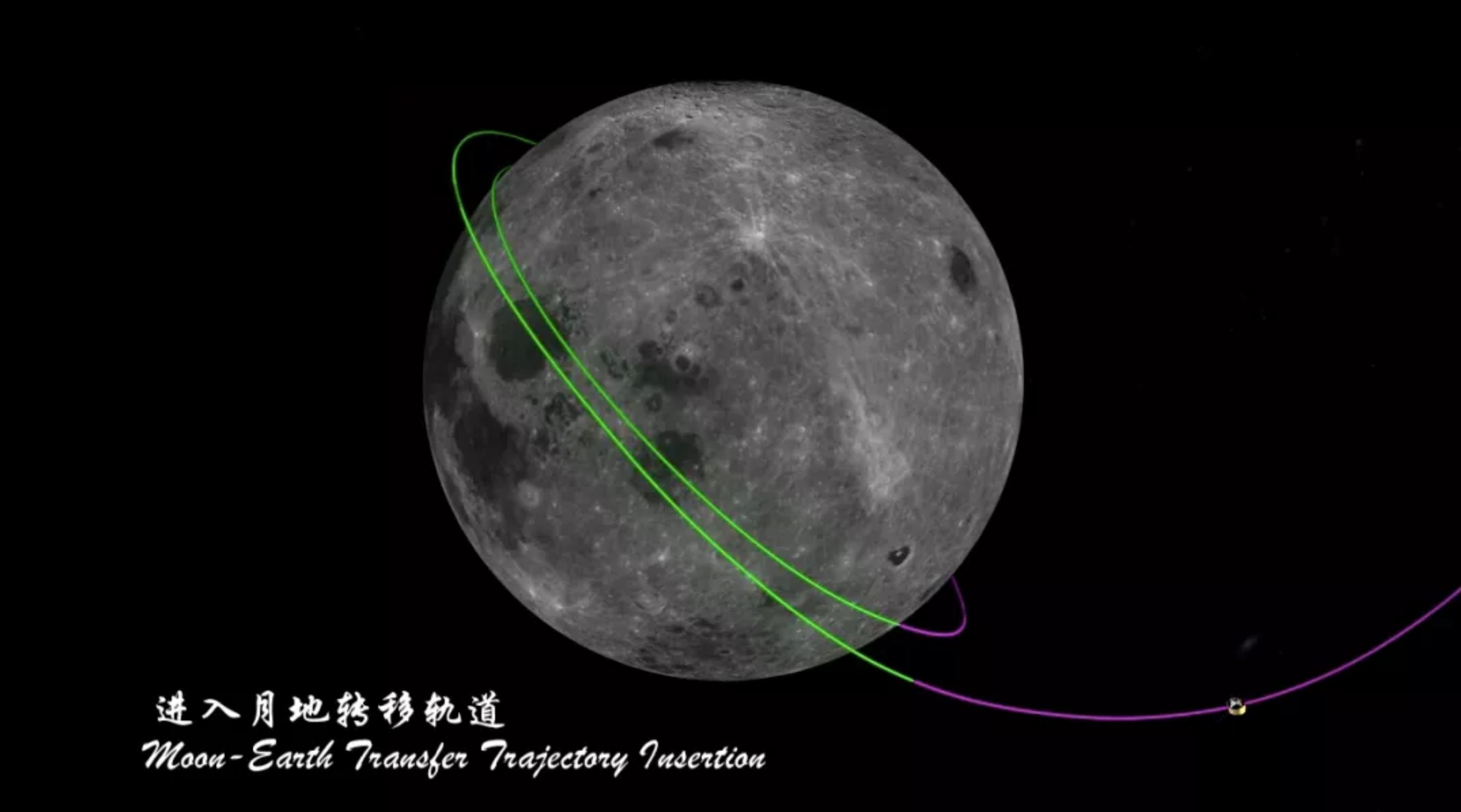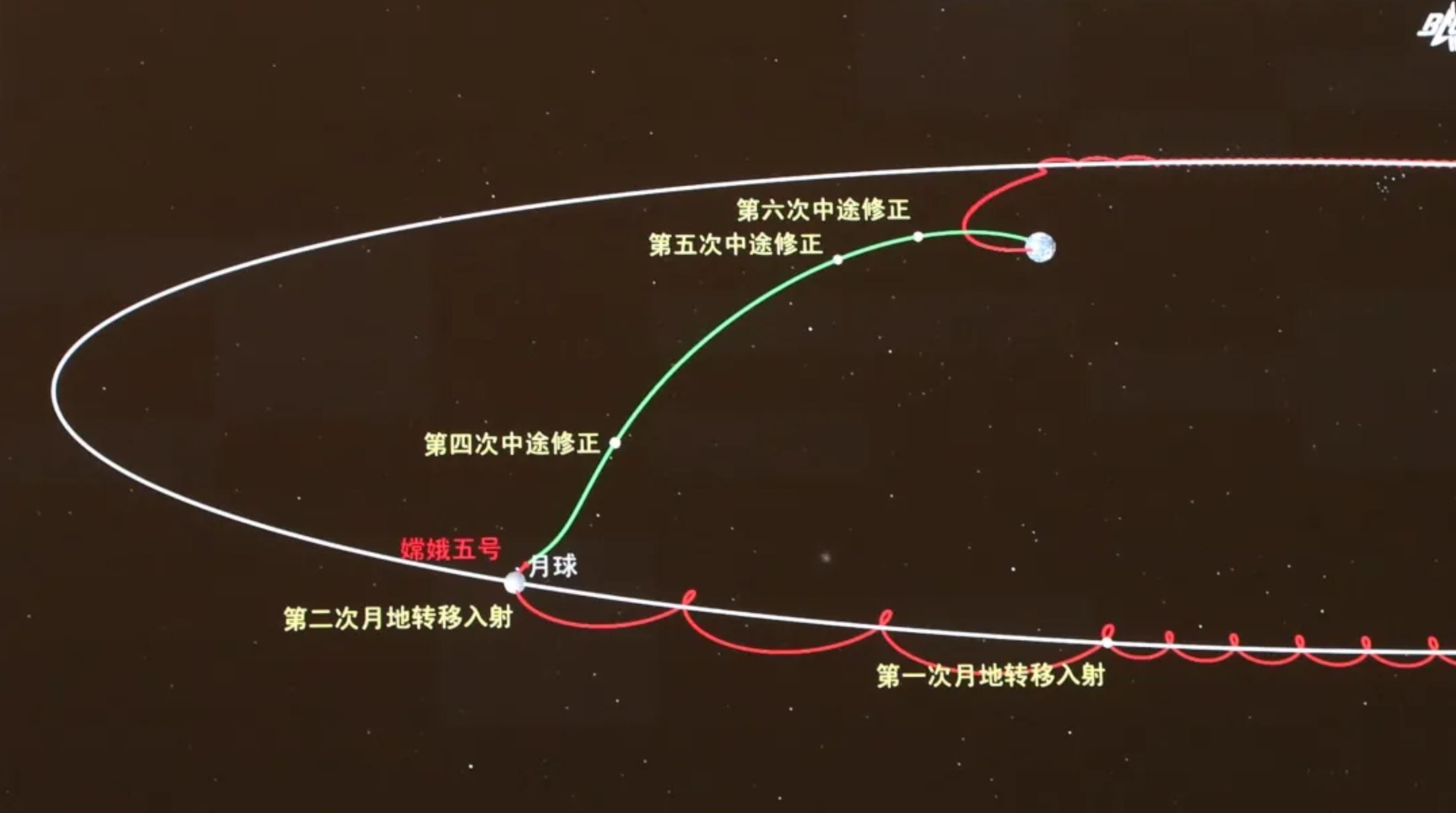China's moon rocks are officially on their way to Earth as Chang'e 5 probe leaves lunar orbit
The first lunar samples in 44 years are a few days away from Earth.

China's Chang'e 5 orbiter is heading home on the final leg of its mission to collect fresh lunar samples from the moon.
The orbiter began firing four 150-Newton engines at 8:51 p.m. EST Saturday (Dec. 12) (0151 GMT, 9:51 am Beijing time Dec. 13) when 143 miles (230 kilometers) above the moon. The engines stopped burning 22 minutes later after setting the spacecraft on a course for Earth.
The mission now enters the final stretch of its 23-day quest to deliver the first lunar samples to Earth since 1976. Scientists hope the material will bring insights into mysteries about the history of our nearest celestial neighbor.
Photos: Amazing panorama shows China's Chang'e 5 landing site on the moon
At 10:13 p.m. EST Sunday (Dec. 13) (0313 GMT, 11:13 a.m. Beijing time Dec. 14) the spacecraft performed a trajectory correction maneuver — another burn of small engines to finetune its path home.
Chang'e 5 is expected to reach Earth around Wednesday (Dec. 16) and deliver its precious cargo of lunar material collected from the moon's Oceanus Procellarum, or "Ocean of Storms." Scientists want to analyze the samples in labs on Earth to confirm theories that this area of the moon is made of rock much younger than other regions.
A container carrying around 4.4 lb. (2 kilograms) of lunar samples sits inside a reentry capsule attached to the orbiter. Closer to Earth, the reentry capsule will separate from the orbiter and attempt entry into the atmosphere.
Breaking space news, the latest updates on rocket launches, skywatching events and more!
The Chang'e 5 reentry capsule will first 'skip' off the atmosphere once to help it slow down, because a journey back from the moon involves far greater speeds than returning from low Earth orbit. After reentry, parachutes will slow the capsule's descent to the ground within an area of Inner Mongolia where China's astronauts also touch down after visits to space.
The complex and daring mission began on Nov. 23, when a Long March 5 rocket launched the four-part Chang'e 5 spacecraft. The spacecraft entered lunar orbit just over four days later and shortly after the mission lander and an ascent vehicle separated from the orbiter.
The lander made a spectacular landing near a volcanic peak named Mons Rümker on Dec 1. The lander quickly set about collecting samples with a drill and robotic arm and loaded the material into an ascent vehicle.
The ascent vehicle blasted off from atop the lander on Dec. 3, and on Dec. 5, the small spacecraft completed the first-ever robotic lunar orbit rendezvous and docking with the waiting Chang'e 5 orbiter. After transferring the samples to the reentry vehicle attached to the orbiter, the ascent vehicle was jettisoned and later commanded to impact the moon to prevent creating debris in lunar orbit.
The orbiter has meanwhile been waiting for the right moment to stop circling the moon and head for home.
After their arrival this week, the samples will be delivered to a specially constructed laboratory in Beijing where preparation, analysis and storage of the moon rocks will begin.
Scientists will use radiometric dating to confirm the age of the new samples, which may contain rocks made by late-stage volcanism as young, geologically speaking, as 1.2 billion years old. The samples collected previously by Apollo and Soviet Luna missions in the 1960s and 1970s are all more than 3 billion years old.
Follow us on Twitter @Spacedotcom and on Facebook.

Andrew is a freelance space journalist with a focus on reporting on China's rapidly growing space sector. He began writing for Space.com in 2019 and writes for SpaceNews, IEEE Spectrum, National Geographic, Sky & Telescope, New Scientist and others. Andrew first caught the space bug when, as a youngster, he saw Voyager images of other worlds in our solar system for the first time. Away from space, Andrew enjoys trail running in the forests of Finland. You can follow him on Twitter @AJ_FI.


